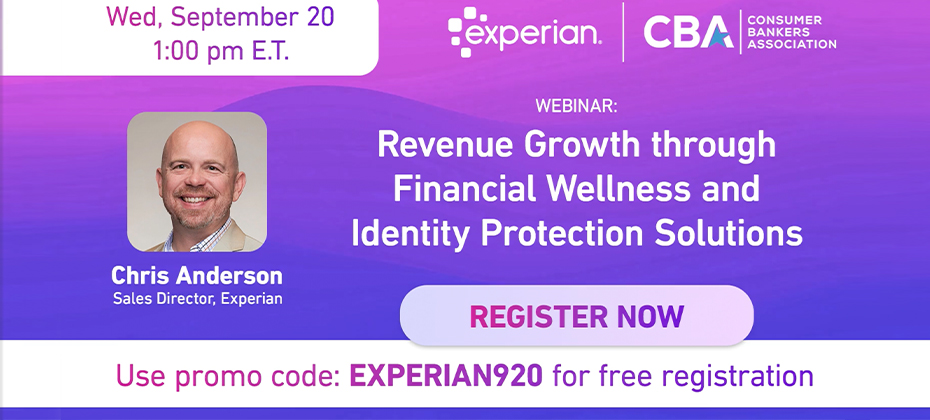Tag: inclusion

Many organizations remain committed to financial inclusion to create better outcomes for underrepresented consumers and small businesses by unlocking barriers to financial well-being and closing the wealth gap. Organizations like credit unions, Community Development Financial Institutions (CDFIs), and Minority Deposit Institutions (MDIs) live by these values. These lenders work hard to ensure these values are reflected in the products and services they offer and in how they attract and interact with customers. While funding from the federal government is being scaled back for many of these community-based financial institutions, Experian is scaling up! We're still here to support CDFIs, Credit Unions, and their members, along their financial inclusion journey. The cross-walk between DEIB and financial inclusion Although Diversity, Equity, Inclusion and Belonging (DEIB) and financial inclusion involve different strategies, there’s an undeniable connection that should ultimately be tied to a business’s overall goal and mission. The communities that are historically underrepresented and underpaid in the workforce – including Black Americans, Hispanic/Latinos, and rural white Americans – also tend to be marginalized by the established financial system. Financial institutions that work to address the inequities within their organizations and promote financial inclusion may find that these efforts complement each other. DEIB policies help promote and support individuals and groups regardless of their backgrounds or differences. While financial inclusion is less specific to a company or organization, instead it describes the strategic approach and efforts that allow people to affordably and readily access financial products, services, and systems. The impact of financial inclusion Lenders can promote financial inclusion in different ways. A bank can change the requirements or fees for one of its accounts to better align with the needs of people who are currently unbanked. Or it can offer a solution to help people who are credit invisible, or unscoreable by conventional credit scoring models, establish their credit files for the first time. Financial institutions also use non-traditional data scoring to lend to applicants that conventional scoring models can’t score. By incorporating alternative credit data[1] (also known as expanded FCRA-regulated data) into their marketing and underwriting, lenders can expand their lending universe without taking on additional risk. Financial inclusion efforts for all Experian is a champion of financial inclusion by supporting both financial institutions and consumers. Through our Inclusion Forward – Experian Empowering Opportunities™ initiative, we work directly with lenders to reach underserved communities and extend greater credit access to consumers. We also offer various tools to help consumers build and understand their credit, and to help financial institutions reach underrepresented communities. We provide individuals with everything from financial inclusion solutions to literacy education to insights about their own financial profile, along with ways to help underrepresented communities improve their financial wellness.* One way that we are doing this is through our consumer programs called Experian Go® and Experian Boost® –that are available for free through the Experian app. These first-of-their-kind programs work together to help consumers improve their credit profile. Experian Go helps individuals establish a credit file, while Experian Boost assists with adding tradelines to an existing credit file. For example, with Experian Boost, individuals can connect positive payments to utility, rent, streaming services, and other accounts to improve their credit scores. Membership with Experian helps consumers monitor their credit, manage their money, and find ways to save money, including shopping for insurance. In fact, consumers saved an average of $828 per year when they switched and saved through Experian Insurance Marketplace.[2] Working together to create financial empowerment There’s no magic solution to undoing the decades of policies and prejudices that have kept certain communities unable to fully access our financial and credit systems. But financial institutions like credit unions, CDFIs and MDIs take steps every day to drive financial inclusion and help underrepresented communities. These values are a part of their business DNA, and Experian is here to help keep their legacy alive. Whether you’ve established your strategy or need help with implementation, we can help you enhance your financial inclusion efforts. Learn more about our helpful solutions. Experian will point you in the right direction to business growth. Visit our website [1] Using Alternative Credit Data for Credit Underwriting. [2] Experian research. *Experian Boost: Results will vary. Not all payments are boost-eligible. Some users may not receive an improved score or approval odds. Not all lenders use Experian credit files, and not all lenders use scores impacted by Experian Boost. Learn more.

The importance of financial wellness and identity protection solutions cannot be overstated. With the increase in financial scams and the ever-changing landscape of the digital world, it is imperative to stay up-to-date with the latest trends and technologies that can help safeguard your consumers’ financial future. Experian will host an exclusive digital sales event in partnership with the Consumer Bankers Association (CBA) and Experian Partner Solutions on this topic. Join Experian’s Director of Sales, Chris Anderson, on September 20 at 1:00 p.m. ET/10:00 a.m. PT to discover the power of credit education and identity protection while learning how to drive revenue, engagement, retention, and new business within your consumer base. Three critical components to driving revenue by empowering consumers: Critical credit education tools: Credit is an integral part of our lives, and yet many people do not fully understand how credit works or how to improve it. Webinar attendees will learn about credit education tools that can help their customers improve their credit scores and make informed financial decisions. These tools can also enable financial institutions to better serve their customers by understanding their needs and providing them with appropriate solutions, fostering greater loyalty. Technologies for identity protection: Identity theft is a growing problem, with many individuals and businesses falling victim to fraud and other scams online. Experian Partner Solutions offers a suite of identity protection tools that can monitor and provide real-time accurate alerts, ensuring that your digital presence is secure. Attendees of the webinar will have the opportunity to learn more about these technologies and how they can take proactive steps to protect themselves and their businesses from cyberattacks. Credit-building strategies and identity theft prevention: Building credit takes time and effort, but with the right strategies, it can be done efficiently and effectively. Our expert speaker, Chris Anderson, will share insights into credit-building strategies that can help individuals boost their credit scores as well as ways to prevent identity theft. For more insights and best practices to promote financial wellness at your organization and increase revenue and retention, join our webinar. Register today! Use promo code: EXPERIAN920 for free registration.

Many organizations commit to diversity, equity, and inclusion (DEI) policies and practices to build a more diverse and just workplace. Organizations that live by these values ensure they're reflected in the products and services they offer, and in how they attract and interact with customers. For financial institutions, there could be a direct link between their DEI efforts and financial inclusion, which can open up growth opportunities. Defining DEI and financial inclusion DEI and financial inclusion aren't new concepts, but it's still important to understand how organizations are using these terms and how you might define a successful outcome. What is DEI? DEI policies help promote and support individuals and groups regardless of their backgrounds or differences. In the Experian 2022 Diversity, Equity and Inclusion Report, we define these terms more specifically as: Diversity: The presence of differences that may include thought, style, sexual orientation, gender identity/expression, race, ethnicity, dis(ability), culture, and experience. Equity: Promoting justice, impartiality, and fairness within the procedures, processes, and distribution of resources by institutions or systems. Inclusion: An outcome to ensure those who self-identify as diverse feel and are welcomed. You meet your inclusion outcomes when you, your institution, and your programs are inviting to all. We also recognize the importance of belonging, or “a sense of fitting in or feeling you are an important member of a group." A company's DEI strategy might include internal efforts, such as implementing hiring and promotion practices to create a more diverse workforce, and supporting employee resource groups to foster a more inclusive culture. Companies can also set specific and trackable goals, such as Experian's commitment to increase its representation of women in senior leadership roles to 40 percent by 2024.1 But DEI efforts can expand beyond internal workforce metrics. For example, you might review how the products or services you sell — and the messaging around those offerings — affect different groups. Or consider whether the vendors, suppliers, nonprofits, communities, and customers you work with reflect your DEI strategy. What is financial inclusion? Financial inclusion is less specific to a company or organization. Instead, it describes the strategic approach and efforts that allow people to affordably and readily access financial products, services, and systems. Financial institutions can promote financial inclusion in different ways. A bank can change the requirements or fees for one of its accounts to better align with the needs of people who are currently unbanked. Or it can offer a solution to help people who are credit invisible or unscoreable by conventional scoring models establish their credit files for the first time. For example, Mission Asset Fund, a San Francisco-based nonprofit, organizes credit-building lending circles that have historical roots in savings programs from around the world. Participants can use them to build credit without paying any interest or fees. In particular, the organization focuses on helping immigrants establish and improve their credit in the U.S. Financial institutions are also using non-traditional data scoring to lend to applicants that conventional scoring models can't score. By incorporating alternative credit data1 (also known as expanded FCRA-regulated data) into their marketing and underwriting, lenders can expand their lending universe without taking on additional risk. READ MORE: Experian's Improving Financial Health Report 2022 has many examples of internal products and external partnerships that help promote financial literacy and inclusion. DEI and financial inclusion can complement each other Although DEI and financial inclusion involve different strategies, there's an undeniable connection that should ultimately be tied to a business's overall goal and mission. The groups who are historically underrepresented and underpaid in the workforce also tend to be marginalized by the established financial system. For example, on average, Black and Hispanic/Latino workers earn 76 percent and 73 percent, respectively, as much as white workers.2 And 27 percent of Black and 26 percent of Hispanic/Latino consumers are either credit invisible or unscoreable, compared to only 16 percent of white consumers.3 Financial institutions that work to address the inequities within their organizations and promote financial inclusion may find that these efforts complement each other. During a webinar in 2022 discussing how financial growth opportunities can also benefit underserved communities, Experian asked participants what they thought was the greatest business advantage of executing financial inclusion in their financial institution or business. The majority of respondents (78 percent) chose building trust and retention with customers and communities — undoubtedly an important outcome. But the second most popular choice (14 percent) was enhancing their brand and commitment to DEI, highlighting how these efforts can be interconnected.4 By building a more diverse workforce, organizations can also bring on talent that better relate to and understand consumers who weren't previously part of the company's target market. If the company culture supports a range of ideas, this can unlock new ways to propel the business forward. In turn, employees can be more engaged and excited about their work. Find partners that can help you succeed Setting measurable outcomes for your DEI and financial inclusion efforts and tracking your progress can be an important part of implementing successful programs. But you can also leverage partnerships to further define and achieve your goals. Experian launched Inclusion ForwardTM with these partnerships in mind. Building on our commitment to DEI and financial inclusion, we offer various tools to help consumers build and understand their credit and to help financial institutions reach underserved communities. Products like Experian GoTM and Experian BoostTM help consumers establish their credit file and add positive utility, rent, and streaming service payments to their Experian credit report. Lenders can benefit from access to various non-traditional credit data and expanded FCRA-regulated scoring models, including Experian's Lift PremiumTM, which can score 96 percent of U.S. adults. Whether you've established your strategy and need help with implementation or are at the starting stages, Experian can help you promote DEI and enhance your financial inclusion efforts. Learn more about driving financial inclusion to bring change 1Experian (2022). 2022 Diversity, Equity and Inclusion Report 2U.S. Department of Labor (N/A). Earnings Disparities by Race and Ethnicity 3Oliver Wyman (2022). Financial Inclusion and Access to Credit 4Experian (2022). Three Ways to Uncover Financial Growth Opportunities that Benefit Underserved Communities.

Conventional credit scoring systems are based on models developed over six decades. As consumer behavior evolves, it's important to seek newer, fresher sources of data to assess creditworthiness. Because the data used by conventional credit scoring models does not provide the full picture of a consumer's financial health, a large population segment of the United States is excluded from accessing credit.With changing times and new technology, forward-thinking financial institutions are using alternative data1 to gain a more holistic consumer view. A move toward inclusive finance, including incorporating alternative data in credit scoring models, is a crucial step towards promoting financial inclusion and helping millions of consumers achieve their financial and personal goals. More importantly, it provides the insight needed for lender confidence, which can help fuel business growth. Understanding limitations of the conventional scoring system Credit scores can be obtained from any one of the major credit bureaus based on information found in a consumer's credit report and are incorporated into a lender's credit-decisioning process. While there are various credit scoring models based on lender preference that could yield slightly different scores, all traditional scores are comprised of credit characteristics within these categories: payment history, credit mix, credit history length, amounts owed and new credit account inquires. Lenders use past credit performance to predict whether extending credit is a risk, posing a major challenge for credit invisible and thin-file consumers and leaving millions at a disadvantage. This dilemma also limits business growth for lenders. Consumers who are unable to access mainstream credit often turn to the alternative financial services (AFS) industry, a $140 billion market that continues to grow by 7-10 percent each year.2 The AFS industry offers consumers additional products, like payday loans, cash advances, short-term installment loans, and rent-to-own loans, none of which are included in a traditional credit file. With alternative credit data, lenders can obtain a more holistic view of creditworthiness and risk, helping to enhance inclusive lending by broadening their pool of potential loan candidates. Why conventional scoring models simply aren't enough Because of the criteria used to assess creditworthiness, conventional credit scoring models do not accurately capture an individual's financial behavior or health. Indeed, many people demonstrate financial responsibility in other legitimate ways that are not reported to the major credit bureaus.In contrast, non-traditional data considers a consumer's everyday financial behavior to provide a more accurate score for lenders. It can include a range of indicators, such as: Bill payments: Consistent payment history on typical household bills (which may have been paid from a debit account). Bank account data: Shows average balance and withdrawal activity and recurring payroll deposits (indicating that a consumer is employed and receives a regular income). Rental data: Indicates a consumer's long-term stability in making regular, on-time monthly rent payments. Registered licenses: Registered licenses or membership with a skilled trade or profession can indicate the likelihood to generate income. Including this type of data can benefit both lenders and applicants. According to an Experian report, by adding alternative credit data to a near-prime population, lenders could see an increase in approvals for consumers historically being left behind. When Clear Early Risk Score™ is paired with the VantageScore® credit score, approvals climb to 16 percent of the population inside the same risk criteria, representing a 60 percent lift in credit approvals for near-prime consumers.2 The pool of people from whom this type of alternative data can reliably be collected is growing, with 70 percent of consumers willing to provide additional financial information to a lender if it increases their chance for approval or improves their interest rate for a mortgage or car loan.3 Plenty of available yet untapped data exists that can add value to a consumer's profile and lead to greater inclusive lending. For example, 95 percent of Americans own a cell phone and about two-thirds of households headed by young adults are being rented. Reporting on this data could potentially "thicken" a credit file and provide deeper insight into a consumer's credit behavior.3Indeed, turning to non-traditional data can expand the credit universe and lead to more inclusive credit scoring models, especially by leveraging existing technology and financial inclusion solutions. Research shows that with Lift Premium™, virtually all of the 21 million conventionally unscorable consumers would become scoreable, and over 1 million of them would have scores in the near-prime range or better. Of these, 1.7 million would be Black American and Hispanic/Latino people.3 For lenders, these numbers reveal potential opportunities to grow their businesses. Of the 255 million adults in the U.S., 19 percent of credit eligible adults are left out of mainstream scoring systems. 28 million are considered credit invisible – meaning they have no credit history (11%). 21 million are considered unscorable – have partial credit history but not enough to generate a score using conventional models (8%). Of the remaining credit eligible adults, 57 million were considered subprime (22%). 106 million U.S. adults can't get mainstream credit rates (42%). Adopting inclusive finance lending practices is not only the right thing to do but also provides financial institutions with the chance to reach untapped markets, grow their business and promote a healthier economy. Financial inclusion is not a destination, but an ever-evolving journey. Don't miss out on this critical opportunity to join the movement. Learn more about our financial inclusion tools to help enhance your inclusive lending approach. 1"Alternative Credit Data,” refers to the use of alternative data and its appropriate use in consumer credit lending decisions, as regulated by the Fair Credit Reporting Act. Hence, the term “Expanded FCRA Data” may also apply in this instance and both can be used interchangeably.2Experian: 2020 State of Alternative Credit Data.3Oliver Wyman white paper, “Financial Inclusion and Access to Credit," January 12, 2022.

More than seven million Americans who are unbanked cite high account fees, insufficient funds to meet minimum balances and a lack of needed products and services as the main reasons for not having a checking or savings account.1 Credit unions understand that being unbanked comes at a steep cost and have turned their focus to developing products and strategies that prioritize financial inclusion — a movement to combat inequities in banking and better serve the financial needs of marginalized communities. In 2022, the House passed Expanding Financial Access for Underserved Communities Act to allow federal credit unions to add underserved areas to their fields of membership as a means of improving financial inclusion. “We believe diversity, inclusion, equity, belonging and accessibility has to be weaved into the strategic fabric of an organization [and its] culture," says Max Villaronga, President and Chief Executive Officer of Raiz Federal Credit Union. “When we don't participate in [diversity, equity and inclusion], we are complicit in essentially keeping people out of the banking system." For credit unions, driving financial inclusion starts with setting a vision that will leave a lasting legacy that includes fostering financial empowerment, closing the credit gap and building generational wealth among the communities they serve. Here's a roadmap for getting started. Best practices for engagement Establishing a set of best practices is the essential starting point for improving financial inclusion. The process begins with the mission statement and extends to all aspects of operations from hiring procedures to sponsorships and donations. Villaronga advocates three strategies for engagement: Engage the leadership team Conversations about financial inclusion need to start at the top. The C-suite must be willing to be honest about the barriers and willing to adopt changes that will make credit unions more inclusive. “[T]hese systemic barriers will exist until somebody deliberately moves them out of the way," Villaronga says. “The people who are feeling those barriers are not in the position to do the moving it's up to [CEOs and CFOs] to decide to do something to make a difference." Making a difference starts with choosing a leadership team that reflects the demographics of local communities. Case in point: At Raiz Federal Credit Union in El Paso, Texas, senior management and the board have LGBTQIA+ representation and include members from diverse racial and ethnic identities. The board of directors has also prioritized creating a pipeline that will attract more diverse talent to the board. “Many of [our board members] come from underserved backgrounds in our border community," Villaronga says. “This is a very personal journey for them because they can see themselves in the lives of the people we're serving." Build trust in underserved communities According to an FDIC Survey, “unbanked" U.S. households listed a lack of trust in financial institutions as a top reason for not having a bank account. And lack of access to a checking or savings account is most prominent among racial and ethnic minorities and low-income communities.2 Actions speak louder than words, according to Villaronga. Raiz Federal Credit Union uses diverse images in its advertising and provides information in both English and Spanish. The credit union was also awarded the Juntos Avanzamos (Together We Advance) designation from Inclusiv for its commitment to serving and empowering Hispanic communities by providing safe, affordable and relevant financial services. Villaronga believes that a designation like Juntos Avanzamos sends the message to the community that the credit union is committed to improving general financial literacy and pre-loan education, as well as reducing higher charge-offs and other barriers to accessing financial services that exist in lending and serving underserved communities. Dispel financial inclusion myths Among traditional financial institutions, myths about financial inclusion are widespread and include falsehoods that pricing products for marginalized communities are too challenging, reaching out is not profitable, and providing financial products to underserved markets is too risky. “Credit unions were really built to extend credit [and] were also originally established to serve consumers that were being ignored by the existing systems that were in place but those consumers are still being ignored today," Villaronga says. “Are those communities too risky to serve? Some companies are serving them [and] they would not be doing so if it was not profitable." Raiz Federal Credit Union offers several affordable loan products — from credit builder loans to citizenship loans and payday lender payoff loans along with credit cards — that allow members to build their credit scores and establish positive credit histories. Rather than pricing loans based on what the competition is charging, Villaronga calculates the fixed and variable costs, failure fraction and target return on assets to get a floor pricing per unit. The approach, he adds, allowed Raiz Federal Credit Union to report earnings of over 150 basis points in 2021 while maintaining a 12 percent capital ratio, proving that financial inclusion is good for the bottom line. “THE IDEA THAT YOU CANNOT [ACHIEVE FINANCIAL INCLUSION] IN A WAY THAT'S SAFE AND SOUND AND SATISFIES THE [NATIONAL CREDIT UNION ADMINISTRATION] IS TRULY A MYTH." - Max Villaronga, President and CEO, Raiz Federal Credit Union Partner for Success For credit unions, an important part of achieving financial inclusion goals is identifying partners that can help. Raiz Federal Credit Union set a goal to increase automated lending from 20 percent to 60 percent, but using a traditional loan origination program was insufficient to hit that target. A partnership with Experian allowed the credit union to access tools that allowed it to better identify non-traditional risks and opportunities, as well as develop more robust lending and optimized decision strategies. Experian launched Inclusion ForwardTM, an initiative to help boost financial inclusion and close the wealth gap, and support financial institutions by enhancing their inclusion approach by leveraging FCRA-regulated data sources (otherwise known as alternative data).3 In addition to providing a deeper view of unbanked and underbanked consumers and reducing friction and speed of decisioning through increased automation, Experian Lift PremiumTM uses income and employer data, social security and financial management insights — transaction behaviors that were historically credit invisible or unscorable — to help credit unions meet the needs of underserved markets and increase opportunities for inclusion. “This automation also allows us to reduce our fixed cost per unit — [and] it's a really big deal because this is not by little, but a lot," Villaronga says. “This lower cost to produce [a loan] allows us to improve our interest rates to underserved members, further creating an appealing value proposition that's in line with our financial inclusion strategy." Access our case study to learn more about how Experian can help grow your business with a frictionless digital prequalification experience. Access now 1Federal Reserve Bank of Cleveland (May 2022). Unbanked in America: A Review of Literature 2 Federal Deposit Insurance Corporation (December 2021). American Banks: Household use of Banking and Financial Services 3When we refer to “Alternative Credit Data," this refers to the use of alternative data and its appropriate use in consumer credit lending decisions, as regulated by the Fair Credit Reporting Act. Hence, the term “Expanded FCRA Data" may also apply in this instance and both can be used interchangeably

You walk into your home, flick the light switch, head to the fridge and grab a glass of cold water. Suddenly, you feel a chill and turn the thermostat up. These habitual acts are basic, but fundamental to our lives. Unfortunately, not everyone has equal access to such luxuries. There is a substantial amount of people who are impacted by heavy energy burdens. What is an energy burden? An energy burden is the percentage of gross household income that goes towards energy costs. Two families can have similar energy bills, but different household incomes. Like many other industries, the utility sector is shifting its’ focus toward equitable outcomes and establishing and implementing effective efficiency programs. Who do energy burdens impact? Due to the energy burden, many communities of color have been historically underserved by energy efficiency and clean energy programs. The energy burden can also impact those who rent, have less efficient appliances or live in older homes. According to the U.S. Census Bureau, as of August, 2022, 23.1% of U.S. adults lived in households that were unable to pay an energy bill in the last 12 months. Additionally, The American Council for Energy-Efficient Economy (ACEE) found that low-income Black, Hispanic and Native American households face dramatically higher energy burdens than average. How can Experian be a partner for energy equity? As the “Consumer’s Bureau,” Experian is deeply committed to putting consumers’ best interests first as we make key decisions to support our clients. Like the energy industry, Experian wants to lessen the energy burden for underserved and low-income communities. This is a business of critical consequence, and we are focused on helping our clients accelerate progress and equity within the communities they serve. As we navigate along this inclusion journey together, we can assist with three core areas: Measure and track: Understand geographies and audience segments containing the largest opportunities for inclusion within the communities you serve. Benchmark and track progress towards your internal diversity and inclusion goals. Determine who qualifies for energy efficiency programs by getting a more accurate view of the communities you serve. Include and reach: By incorporating supplementary data sources, we can help you identify and reach underserved consumers and small business owners who are often excluded from the traditional credit ecosystem. Inform and empower: Develop and educate vulnerable populations, offering the tools and support needed to advance their financial health journey. Enabling your consumers to obtain the assistance they need. By leveraging our leading data assets, businesses can obtain a more holistic consumer view to drive better outcomes and opportunities while making smarter decisions and minimizing risk. With accurate data you can effectively prioritize field work, get correct assessment of household income, increase productivity of field personnel, and improve field collection rates. We care about doing the right thing and are here to ensure you meet your energy efficiency and equity goals. Together, we can make a positive impact on our communities and consumers. To learn more about how Experian is helping the utility industry drive inclusion and bring equity to energy, visit us or request a call. Access the infographic Energy Burden Research. Aceee.org. (2022). Household Pulse Survey. Census.gov. (2022). Low-Income Households, Communities of Color Face High Energy. Aceee.org. (2022). Experian and Oliver Wyman find expanded data and advanced analytics can improve access to credit. Experian plc. (2022).